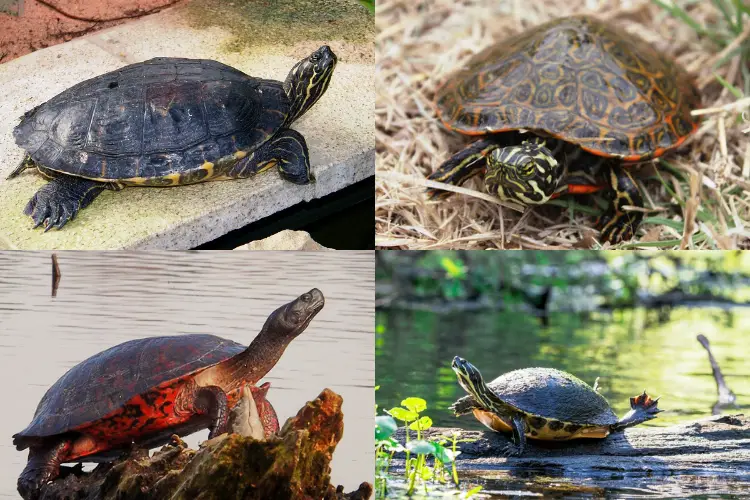Types of Cooter Turtles
There are 7 Cooter turtles in the US including the river Cooter, coastal plain coaster/Florida Cooter, northern red-bellied Cooter, and others. These turtle species are native to the southeastern regions of the united states.
Cooter turtles are good for keeping as pets due to their gorgeous appearance as well as the fact that peacefully cohabit with other turtles. Various Cooters are hard to tell apart as they look almost similar in many ways and behaviors.
The following article will give you a clear picture of what each Cooter turtle looks like, what it eats, where it lives, and the average adult size to help you understand them better. We’ll also touch on the conservation status (IUCN) of these turtles.
1. River Cooter
Contents
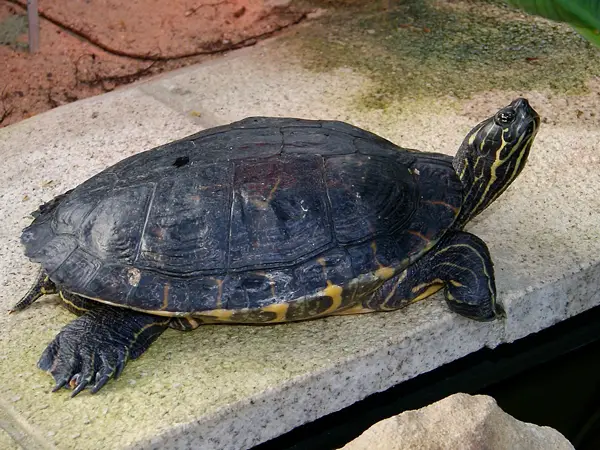
- Scientific name: Pseudemys concinna
- Common name: River Cooter
- Family: Emydidae
- Size: 8 to 12 inches
- Lifespan: 20 to 40 years
- Conservation status: Least Concern
River Cooter turtles are inhabitants of West Virginia, Alabama, Georgia, Florida, Indiana, Kansas, Illinois, Arkansas, Virginia, Kentucky, Missouri, Tennessee, North Carolina, Louisiana, and South Carolina.
They’re known to be solitary creatures and often like basking alone in the sun. However, they can be sometimes observed sharing habitat with painted turtles and red-eared sliders.
They’re distinguishable by their brown to olive or dark-green outer shell and lighter c-shaped, concentric markings in their scutes. Their skin can be olive or olive-brown in color, with numerous yellow lines.
Most of these turtle adults are around 8 to 12 inches in size, though it’s not rare to come across females with a bigger size—up to 15 inches.
These turtles are pretty fast both on land and in water. They’re found in various freshwater bodies including lakes, ponds, and rivers. They’re also found in brackish water.
Their diet is primarily herbivorous and mainly consists of various forms of aquatic vegetation and land plant matter, including fruits and vegetables. They’re however known to occasionally feed on insects and snails.
2. Coastal Plain Cooter
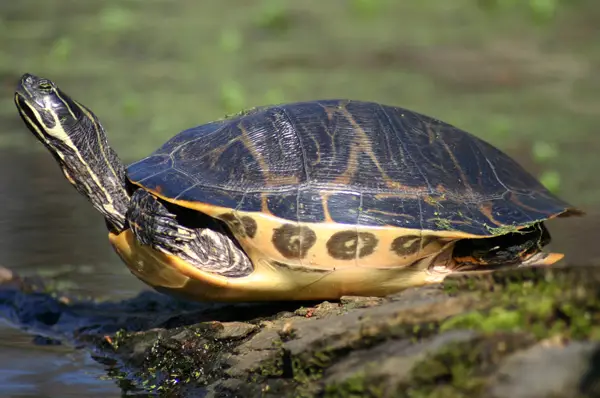
- Scientific name: Pseudemys floridana
- Common name: Florida Cooter, Coastal Plain Cooter
- Family: Emydidae
- Size: 8 to 12 inches
- Lifespan: 20 to 40 years
- Conservation status: Least Concern
The Florida Cooter is one of the largest turtle species inhabiting South Carolina, Alabama, Virginia, Florida, and North Carolina.
The average adult size is 8 to 12 inches long (with the record length being 16 inches!).
This Cooter features an upper shell that’s colored brown to olive green, sometimes it can be dark green. On top of this, the feature light vertical stripes on its outer shell—this is the distinctive feature separating it from its cousins.
Florida cotter species like living in marshes, rivers, swamps, or lakes.
They tend to get pretty nervous, so it’s best to observe them and not handle or suddenly approach them, especially when in the wild. Otherwise, they can feel intimidated and stressed and retreat back to the waters.
They’re primarily herbivorous and are often observed feeding on fruits, veggies, and various other forms of aquatic vegetation.
However, they aren’t 100% herbivorous and can be seen feeding on insects and snails if they’re easily caught or if they’re abundant.
3. Northern Red-Bellied Cooter
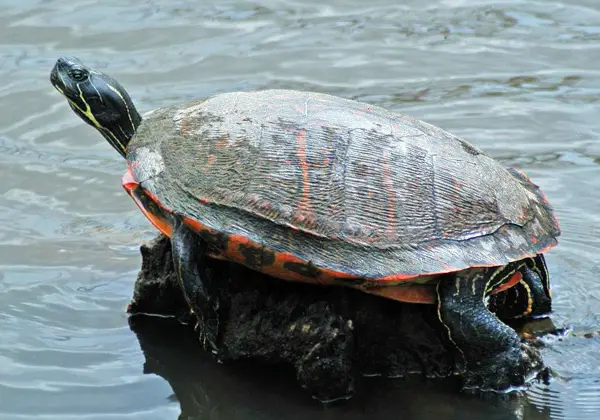
- Scientific name: Pseudemys rubriventris
- Common name: Northern Red-Bellied Turtle,American red-bellied turtle
- Family: Emydidae
- Size: 10 to 12 inches
- Lifespan: 40 to 60 years
- Conservation status: Not Threatened
The Northern redbelly Cooter is present in several states including Maryland, New York, West Virginia, New Jersey, Virginia, Delaware, Massachusetts, Pennsylvania, and North Carolina.
As you can tell from its name, this species features a completely red (vibrant) plastron, sometimes covered with green spots. The turtle is known to live in freshwater streams, ponds, and lakes.
And when the conditions allow, the turtle will venture into brackish streams near the coast.
A redbelly Cooter differs from other turtles with its head pattern which has lighter markings forming a distinct arrow shape, pointing toward the snout. The upper shell ranges form from dark brown to black.
Northern redbelly turtles are mainly herbivorous, and will mostly feed on aquatic plants.
Note that this turtle species faces many threats including wetland loss, habitat loss, pollution, and collection for selling as pets.
At some point, this turtle was even sold for consumption (some countries still consume it even today!)
4. Rio Grande Cooter
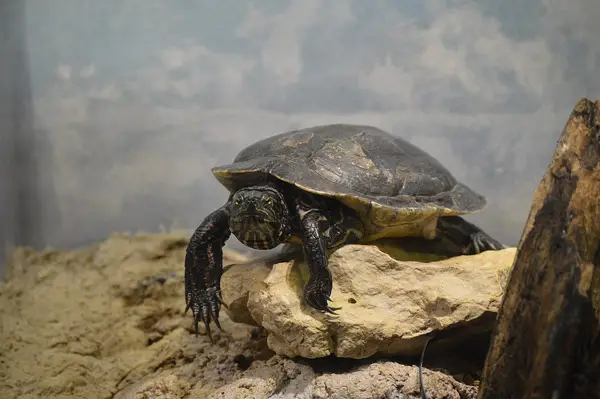
- Scientific name: Pseudemys Gorzugi
- Common name: Western River Cooter, Rio Grande River Cooter
- Family: Emydidae
- Size: 8 to 12 inches
- Lifespan: 20 to 40 years
- Conservation status: Near Threatened
The Rio Grande Cooter is a semi-aquatic turtle that inhabits Texas and New Mexico.
It is mainly found in larger ponds and rivers with decent depths. It gets its name from the Rio Grande river in New Mexico and Texas, where it was first spotted.
This Cooter is easily identified by its shell which is usually olive green or dark brown, or even black. Its rearward scutes also appear slightly jagged.
Swirling patterns of red, orange, or yellow lines can also be seen. As for the plastron, it’s usually yellowish or reddish.
A Rio Grande Cooter is usually omnivorous and prefers feeding on plants and vegetation. On an occasional basis, however, it can be seen eating mollusks or invertebrates.
Unfortunately, the population of this Cooter continues to go down due to pollution as well as water diversion projects. This explains why it is classified as near threatened.
5. Alabama red-bellied Cooter
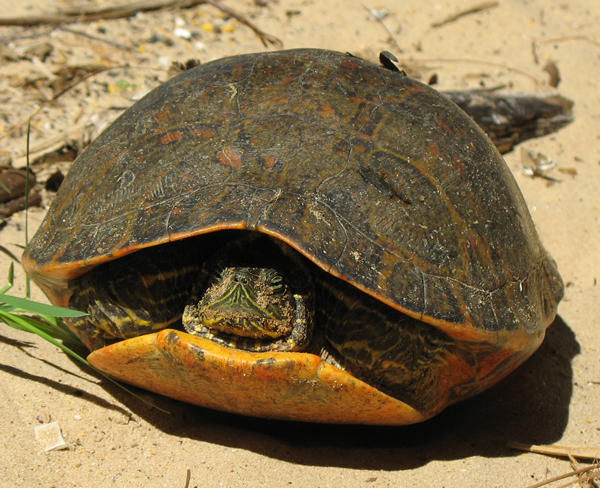
- Scientific name: Pseudemys alabamensis
- Common name: Alabama red-bellied turtle, Red-belly, Slider, Cooter
- Family: Emydidae
- Size: 8 to 12 inches
- Lifespan: 40 to 60 years
- Conservation status: Not Threatened
Alabama red-belly Cooter lives in the fresh, shallow waters of Alabama and Mississippi states. However, it’s not uncommon to come across one in slightly brackish waters.
These turtles are average-sized compared to most species and can reach between 8 and 12 inches in length.
The redbelly scooter usually has a dark brown shell color, with some orange or red coloring on its edges. The lower side of the shell is usually red or orange. The turtle’s skin is usually black or dark brown and is covered by orange or yellow stripes.
Young Alabama red-bellied turtles have more intense and bright coloring, but it fades as they age.
The turtles are, mainly herbivorous and fed on aquatic plants, algae, and land vegetation (they feed on this when basking or nesting). Mind you, this turtle is much easier to find when it’s foraging.
Alabama redbelly turtles are quite nervous and like basking on logs in the sun. They quickly retreat back into the water if they feel threatened or disturbed.
6. Peninsula Cooter
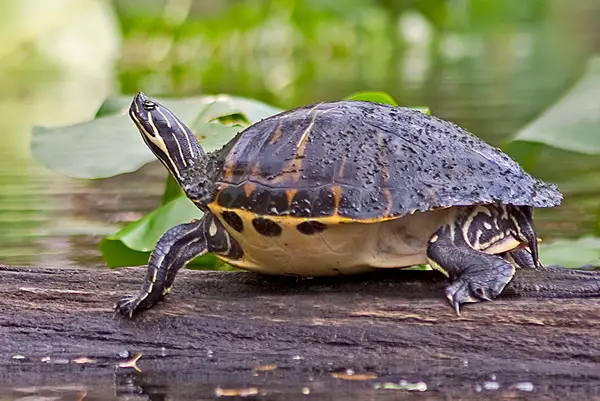
- Scientific name: Pseudemys peninsularis
- Common name: Peninsula Cooter
- Family: Emydidae
- Size: 9 to 13 inches
- Lifespan: 30 years
- Conservation status: Least Concern
The Peninsula Cooter is a freshwater turtle species endemic to Florida state.
It is a medium-sized species featuring a dark-colored upper shell with yellow or orange patterns. It has a lighter plastron compared to the Florida red-bellied Cooter.
Its preferred habitat is in the canals and lakes in Florida, and can sometimes be spotted in the Everglades.
This native Florida Cooter is a close relative to the coastal plain Cooter and some scientists even consider it a sub-species.
Remember that telling apart this Cooter from other Cooter species may be challenging due to how similar it is in physical appearance.
The thin, light lines on the head and top shell (also known as hairpins), are a good clue that you are looking at the Peninsula Cooter!
7. Hieroglyphic River Cooter
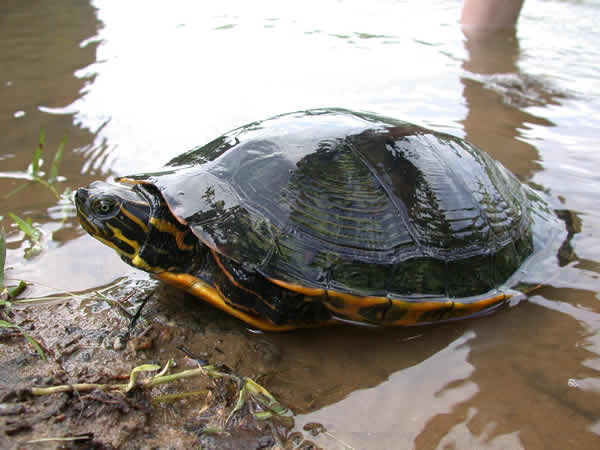
- Scientific name: Pseudemys concinna hieroglyphica
- Common name: River Cooter
- Family: Emydidae
- Size: 8 to 12 inches
- Lifespan: 20 to 40 years
- Conservation status: Least Concern
River Cooter turtles are inhabitants of Indiana and Tennessee. They’re known to be solitary creatures and often like basking alone in the sun.
However, they can be sometimes observed sharing habitat with painted turtles and red-eared sliders.
They’re distinguishable by their green-brown or black carapace with red or orange patterns resembling hieroglyphics. Their plastron is light colored while the skin is covered with pronounced stripes ranging in color from yellow to orange or red.
Most of these turtle adults are around 8 to 12 inches in size, though it’s not rare to come across females with a bigger size—up to 15 inches.
These turtles are pretty fast both on land and in water. They’re found in various freshwater bodies including lakes, ponds, and rivers. They’re also found in brackish water.
Their diet is primarily herbivorous and mainly consists of various forms of aquatic vegetation and land plant matter. They also occasionally feed on insects and snails.
Conclusion
The Cooter turtles in the US are endemic to the southeastern region and include the river Cooter, Florida Cooter, hieroglyphics river Cooter, Alabama red-bellied Cooter, peninsula Cooter, Alabama red-bellied cotter, Rio Grande Cooter, and northern red-bellied Cooter.
Rio Grande Cooter is the only Cooter that’s threatened while most of the other species have the least concern or not threatened conservation statuses.
Cooter turtles have pretty similar appearances, characteristics, and behavior, and telling them apart can be quite hard, even for experienced biologists and vets. Nonetheless, we hope that our description of each Cooter in this guide will give you a good picture of what it looks like and its habits.


